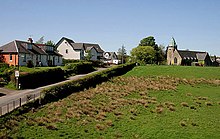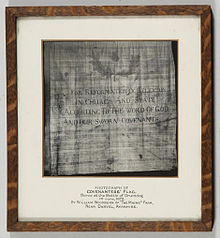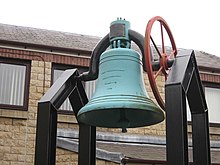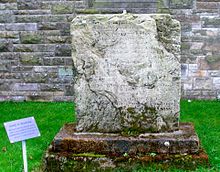| This article needs additional citations for verification. Please help improve this article by adding citations to reliable sources. Unsourced material may be challenged and removed. Find sources: "Battle of Drumclog" – news · newspapers · books · scholar · JSTOR (May 2011) (Learn how and when to remove this message) |
| Battle of Drumclog | |||||||
|---|---|---|---|---|---|---|---|
| Part of Scottish Covenanter wars | |||||||
 Monument to the Battle of Drumclog | |||||||
| |||||||
| Belligerents | |||||||
|
|
| ||||||
| Commanders and leaders | |||||||
|
|
| ||||||
| Registered battlefield | |||||||
| Designated | 30 November 2011 | ||||||
| Reference no. | BTL21 | ||||||
| Covenanter Rebellion of 1679 | |
|---|---|
The Battle of Drumclog was fought on 1 June 1679, between a group of Covenanters and the forces of John Graham of Claverhouse, at Drumclog, in South Lanarkshire, Scotland.
Battle
Following the assassination of Archbishop James Sharp on Magus Muir and the Declaration of Rutherglen, the Covenanters were on the verge of open rebellion. A large conventicle was planned to take place at Loudoun Hill, on the boundary of Ayrshire and Lanarkshire, in defiance of government persecution of the Covenanters. On the morning of Sunday 1 June, the Rev. Thomas Douglas allegedly broke off his sermon with the words "Ye have got the theory, now for the practice", when it was reported that the dragoons of Claverhouse were heading to the area. Claverhouse, better known to his enemies as 'Bluidy Clavers', had recently been appointed captain, with a mission to disperse conventicles in south west Scotland.

A group of around 200 armed Covenanters moved east, to a boggy moor near the farm of Drumclog. With about 40 mounted men, and armed with muskets and pitchforks, the Covenanter force was no rabble. Commanded by Robert Hamilton, the army took up a strong position behind a bog, or 'stank'. Claverhouse's force arrived, but were unable to engage the enemy directly due to the ground conditions. For some time groups of skirmishers exchanged fire across the stank, and Claverhouse felt he was gaining the upper hand. However, he was still unable to get his troops close to the Covenanters without becoming bogged down.
At this point, the Covenanters decided to press the attack. William Cleland led a force around the stank, and advanced rapidly. Despite heavy fire from the government troops, the attack was entirely successful. The line of Claverhouse's force broke, and the dragoons were soon routed from the battlefield, leaving 36 dead.
The victory was a huge success for the rebellious Covenanters, although euphoria was short lived. Just three weeks later Claverhouse, under the leadership of the Duke of Monmouth, helped to crush the rebellion at the Battle of Bothwell Brig.
In the aftermath of the battle a trumpeter fleeing the battle is said to have been caught and killed by covenanters at Caldermill and the Trumpeter's Well named in his memory.
A dubious account of the battle, attributed to the Laird of Torfoot allegedly written by Thomas Brownlee of the Covenanter army, was published in 1822. This followed a fictionalised version which appeared in Sir Walter Scott's novel Old Mortality in 1816. The battle is also remembered in a Child Ballad Loudoun Hill, or Drumclog. Claverhouse himself also left an account of the battle.
Memorials to the battle


The Battle of Drumclog is celebrated by some in Scotland as a victory for religious freedom. In 1839 a monument was erected on the site of the battle, and in 1859 a school house was erected nearby. This monument was struck by lightning and the current monument was built to replace it in 1867.
The battlefield has been inventoried and protected by Historic Scotland under the Scottish Historical Environment Policy of 2009.
The Boston Church in Duns, in the Scottish Borders, had a bell named in memory of the battle. The church was demolished in the 1950s, but the bell is preserved on the site.
In 1905 the Darvel and Strathaven Railway opened, with a station at Drumclog, 1.2 miles (1.9 km) south west of the battle site. By 1912 the village which had grown up here required a church, and the Drumclog Memorial Kirk was constructed. Inside the kirk, located on the A71 Edinburgh to Kilmarnock road, is a stained glass window depicting the Covenanters, and a painting of the Covenanters' army standard. The kirk holds an annual memorial service on the first Sunday in June, at the Drumclog Monument.
The Covenanters' flag from this battle at Drumclog now resides in a museum in Scotland. Under a Scottish thistle the flag says, "For Reformation of Religion In Church And State According To The Word Of God And Our Sworn Covenants."
Bibliography
- W. Aiton's History of the Rencounter at Drumclog (Hamilton, 1821)
- vol vii. , pp. 221–226, of Hill Burton's History of Scotland (ed. 1876)
- vol. i., p. 178, of Carlyle's Reminiscences (1881).
See also
- River Irvine - Death on the River Irvine
- David Hackston
- Henderson, Thomas Finlayson (1895). "Nimmo, James". In Lee, Sidney (ed.). Dictionary of National Biography. Vol. 41. London: Smith, Elder & Co.
- John Nisbet
- John Welsh of Irongray
More Brownlee versions:
- Battle of Drumclog – via Wikisource.
- Narrative of the Battles of Drumclog, and Bothwell Bridge (1828) – via Wikisource.
- Narrative of the battles of Drumclog, and Bothwell Bridge (2)/The Battle of Drumclog – via Wikisource.
References
Citations
- ^ Groome 1882.
- Jardine 2017a.
- Scott 1913.
- "Battle of Drumclog". www.covenanter.org.uk. Retrieved 14 February 2022.
- Historic Environment Scotland.
- Aiton 1821.
Sources
- Aiton, William (1821). A History of the Rencounter at Drumclog, and Battle at Bothwell Bridge, in The Month Of June 1679, with an Account of what is correct, and what is fictitious in the "Tales of my Landlord" respecting these engagements, and Reflections On Political Subjects. Hamilton: Printed by W. D. Borthwick and Co. Retrieved 20 June 2020.
- Brownlee, Thomas (1820a). Narrative of the battles of Drumclog and Bothwell Bridge. Glasgow: Printed for the booksellers (based on the National Gazette article by the laird of Torfoot). pp. 1–24. Retrieved 20 June 2020.
- Brownlee, Thomas (1820b). Battle of Drumclog, fought on the 1st June, 1679 between the king's troops and the covenanters. By the Laird of Torfoot …. Glasgow: Printed for the booksellers (based on the National Gazette article by the laird of Torfoot). pp. 1–28. Retrieved 20 June 2020.
- Creichton, John (1827). Swift, Jonathan (ed.). The Memoirs of Captain John Creichton: From His Own Materials. Vol. 11. London: Re-printed for Hunt and Clarke. pp. 28–37. Retrieved 20 June 2020.
- Douglas, J. D. (1964). Light in the north : the story of the Scottish Covenanters (PDF). W. B. Eerdmans Pub. Co. p. 140. Retrieved 22 April 2019.
- Drummond, James (1862). "Notice of the "Bluidy Banner" of Drumclog and Bothwell Brig, preserved at Dunbar". Proceedings of the Society of Antiquaries of Scotland. 3: 253–258. doi:10.9750/PSAS.003.253.258. S2CID 194403911. Retrieved 20 June 2020.
- Gibson, James (1881). Inscriptions on the tombstones and monuments erected in memory of the Covenanters; with historical introduction and notes. Glasgow: Dunn & Wright. pp. 29–33. Retrieved 20 June 2020.
- Gilfillan, George (1883). "The Battles of Drumclog and Bothwell Bridge, with their results". The martyrs and heroes of the Scottish covenant (5 ed.). Edinburgh; London: Gall & Inglis. pp. 69–109. Retrieved 20 June 2020.
- Groome, Francis Hindes (1882). "Drumclog". Ordnance gazetteer of Scotland : a survey of Scottish topography, statistical, biographical, and historical. Vol. 2. Edinburgh: T.C. Jack. p. 372. Retrieved 6 June 2020.
- Henderson, Thomas Finlayson (1890). "Graham, John (1649?–1689)". In Stephen, Leslie; Lee, Sidney (eds.). Dictionary of National Biography. Vol. 22. London: Smith, Elder & Co.
- Henderson, Thomas Finlayson (1890). "Hamilton, Robert (1650–1701)". In Stephen, Leslie; Lee, Sidney (eds.). Dictionary of National Biography. Vol. 24. London: Smith, Elder & Co.
- Historic Environment Scotland. "Battle Of Drumclog (44797)". Canmore. Retrieved 14 May 2020.
- Hewison, James King (1913). The Covenanters. Vol. 2. Glasgow: John Smith and son. pp. 300–303. Retrieved 22 July 2019.
- Howie, John; Carslaw, W. H. (1870). "William Gordon of Earlstoun". The Scots worthies. Edinburgh: Oliphant, Anderson, & Ferrier. pp. 403–409.
- Howie, John; Carslaw, W. H. (1870). "Sir Robert Hamilton of Preston". The Scots worthies. Edinburgh: Oliphant, Anderson, & Ferrier. pp. 597–607.
- Jardine, Mark (11 February 2017a). "The Battle of Drumclog: "Torfoot's Account"". Jardine's Book of Martyrs. Retrieved 27 July 2019.
- Jardine, Mark (23 February 2017b). "The Battle of Drumclog, 1679: Wilson's Version". Jardine's Book of Martyrs. Retrieved 27 July 2019.
- Scott, Hew (1917). "Thomas Douglas". Fasti ecclesiae scoticanae; the succession of ministers in the Church of Scotland from the reformation. Vol. 2. Edinburgh: Oliver and Boyd. p. 225. Retrieved 15 March 2019.
 This article incorporates text from this source, which is in the public domain.
This article incorporates text from this source, which is in the public domain. - Scott, Sir Walter (1913). Old mortality – with introductory notes and essay by Andrew Lang. Vol. 5. London: Macmillan and Co. Ltd. pp. 608–610. Retrieved 20 June 2020.
- Smellie, Alexander (1903). "XXII Those that were Stout of Heart are Spoiled". Men of the Covenant : the story of the Scottish church in the years of the Persecution. Vol. 2. New York: Fleming H. Revell Co. pp. 40–47. Retrieved 11 July 2019.
- Wilson, William (1751). True and impartial relation of the persecuted Presbyterians in Scotland; their rising in arms, and defeat at Bothwell-Bridge, in the year 1679. Glasgow: Printed by John McCallum, for William Wilson, Schoolmaster in the Parish of Douglas, Clydsdale, and sold by Robert Smith, bookseller, at the Sign of the gilt Bible, Salt-mercat. pp. 1–80. Retrieved 20 June 2020.
- Wodrow, Robert (1830). Burns, Robert (ed.). The history of the sufferings of the church of Scotland from the restoration to the revolution, with an original memoir of the author, extracts from his correspondence, and preliminary dissertation. Vol. 3. Glasgow: Blackie, Fullarton & co. pp. 69–72. Retrieved 16 February 2019.
External links


- Film footage of the memorial kirk and memorial
- Picturesque Scotland: Drumclog
- Drumclog Memorial Kirk
- Historic Environment Scotland. "Battle of Drumclog (BTL21)".
55°37′54″N 4°11′05″W / 55.63168°N 4.18459°W / 55.63168; -4.18459
Categories: